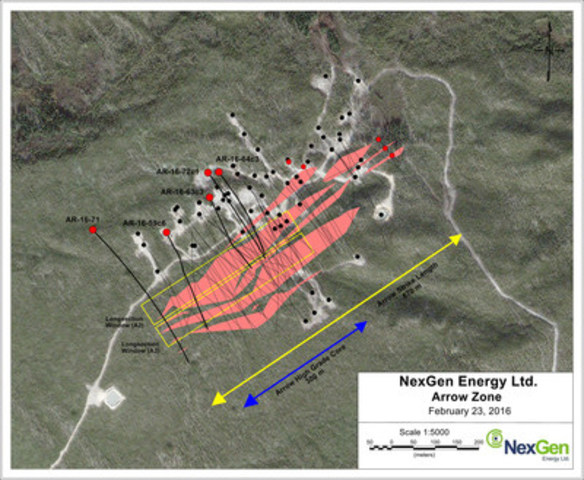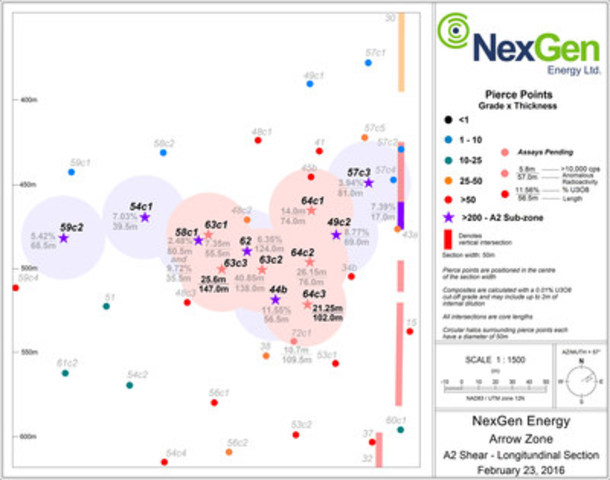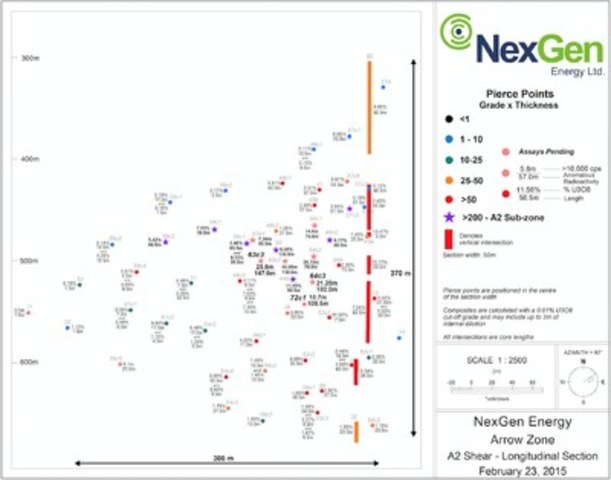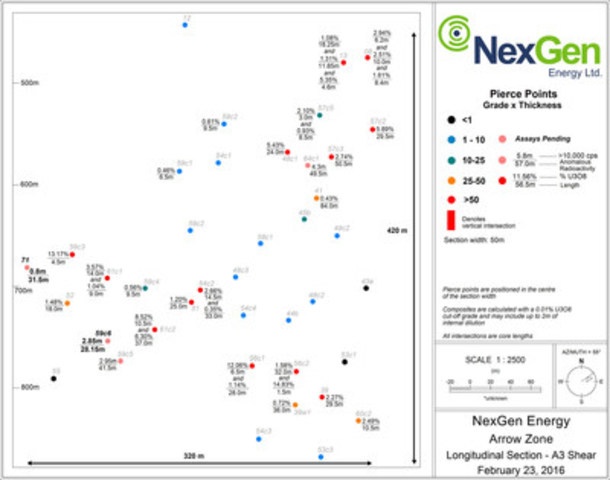
VANCOUVER, Feb. 23, 2016 /CNW/ - NexGen Energy Ltd. ("NexGen" or the "Company") (TSXV:NXE, OTCQX:NXGEF) is pleased to announce results from five angled holes from our on-going 30,000 m winter 2016 drilling program on our 100% owned Rook I Property, Athabasca Basin, Saskatchewan.
All five holes reported in this news release have returned off-scale radioactivity measuring >10,000 counts-per-second ("cps"). The higher grade A2 sub-zone (the "Sub-Zone"), which features the strongest and most extensive uranium mineralization at the Arrow zone, continues to return outstanding results. Holes AR-16-63c3 and AR-16-64c3 both intersected high-grade, widespread, intense visible pitchblende mineralization marked by 25.6 m and 21.25 m of off-scale radioactivity, respectively. The Sub-Zone is currently defined by thirteen drill holes with assay results for six of these holes still pending.
Also, hole AR-16-72c1 which was drilled outside of the Sub-Zone intersected strong visible uranium mineralization in the A2 shear, 27 m down-dip and northeast of hole AR-15-44b (56.5 m at 11.55% U3O8, see News Release dated June 15, 2015). Furthermore, hole AR-16-71 has extended the strike length of the Arrow zone by 25 m to 670 m from 645 m. Arrow remains open in all directions and at depth.
Highlights:
A2 Shear:
- AR-16-63c3 (18 m down-dip and southwest from AR-16-62) intersected 147.0 m of total composite mineralization including 25.6 m of total composite off-scale radioactivity (10,000 - >61,000 cps) within a 197.5 m section (444.0 to 641.5 m) in the Sub-Zone.
- AR-16-64c3 (20 m northeast of AR-15-44b) intersected 102.0 m of total composite mineralization including 21.25 m of total composite off-scale radioactivity (10,000 - >61,000 cps) within a 149.0 m section (465.0 to 614.0 m) in the Sub-Zone.
|
Table 1: Higher Grade A2 Sub-Zone Drill Hole Comparison
|
|
|
|
|
|
|
|
|
|
|
|
|
|
|
|
AR-15-
59c22
|
AR-15-
54c12
|
AR-15-
58c12
|
AR-16-
63c11
|
AR-16-
63c3
|
AR-15-
622
|
AR-16-
63c21
|
AR-15-
44b2
|
AR-16-
64c3
|
AR-16-
64c21
|
AR-16-
64c11
|
AR-15-
49c22
|
AR-15-
57c32
|
|
Total composite mineralization =
|
75.50 m
|
42.00 m
|
86.00 m
|
55.50 m
|
147.00 m
|
143.00 m
|
138.00 m
|
135.60 m
|
102.00 m
|
76.00 m
|
74.0 m
|
73.50 m
|
62.50 m
|
|
Total Off-scale (>10,000 to 29,999 cps)3 =
|
11.40 m
|
5.90 m
|
14.30 m
|
6.85 m
|
22.10 m
|
17.75 m
|
17.10 m
|
30.25 m
|
18.75 m
|
15.95 m
|
10.30 m
|
15.70 m
|
4.40 m
|
|
Total Off-scale (>30,000 to 60,999 cps)3 =
|
4.50 m
|
3.00 m
|
3.85 m
|
0.50 m
|
3.00 m
|
10.60 m
|
9.90 m
|
7.75 m
|
2.50 m
|
4.70 m
|
3.70 m
|
5.20 m
|
2.50 m
|
|
Total Off-scale (>61,000 cps)3 =
|
1.00 m
|
0.50 m
|
2.00 m
|
0.00 m
|
0.50 m
|
2.00 m
|
13.85 m
|
1.50 m
|
0.00 m
|
5.50 m
|
0.00 m
|
2.15 m
|
1.80 m
|
|
Continuous GT (Grade x Thickness) =
|
371
|
277
|
200 and
345
|
Assays
Pending
|
Assays Pending
|
787
|
Assays Pending
|
655
|
Assays Pending
|
Assays Pending
|
Assays Pending
|
605
|
319
|
|
|
1 radioactivity results previously released
|
|
|
2 radioactivity and assays results previously released
|
|
|
3 minimum radioactivity using RS-120 gamma spectrometer
|
|
|
|
|
|
|
|
|
|
A3 Shear:
- AR-16-59c6 (48 m down-dip and southwest of AR-15-61c2) intersected 28.15 m of total composite mineralization including 2.85 m of total composite off-scale radioactivity (>10,000 to 54,000 cps) within a 64.0 m section (768.0 to 832.0 m) in the A3 shear.
- AR-16-71 (58 m down-dip and southwest of AR-15-52) intersected 31.5 m of total composite mineralization including 0.8 m of total composite off-scale radioactivity (>10,000 to 25,000 cps) within a 113.0 m section (582.0 to 695.0 m) in the A3 shear.
Arrow, Activities & Financial
- The land-based and basement hosted Arrow zone now currently covers an area of 670 m by 235 m with a vertical extent of mineralization commencing from 100 m to 920 m, and remains open in all directions and at depth.
- The winter 2016 program comprising 30,000 m of drilling continues with six drill rigs active.
- The release of a maiden NI 43-101 resource estimate on the Arrow zone is scheduled for the first half of 2016.
- The Company has cash on hand of approximately $31M.
Drill hole locations, and the A2 Sub-Zone, A2 & A3 long sections are shown in Figures 1 to 4. Table 2 has a summary of the mineralized intervals.
Garrett Ainsworth, Vice-President, Exploration and Development, commented: "Drill holes AR-16-63c3 and -64c3 have significantly grown the higher grade A2 sub-zone with consistent high grade mineralization over wide intervals. Further testing within the A2 and A3 shears continues to show strong continuity through infill drilling, and substantial expansion from step out drilling."
Leigh Curyer, Chief Executive Officer commented: "Combining the radioactivity results of holes released since January 1, 2016 with today's results, indicates the winter 2016 program is already the most successful to date at Arrow. We look forward to delivering the maiden resource estimate on Arrow along with the results from continued infill, expansion and regional drilling along strike."
Table 2: Arrow Zone Drill Hole Data
|
Drill Hole
|
Athabasca
Group -
Basement
Unconformity
Depth (m)
|
Handheld Scintillometer Results (RS-120)
|
|
Hole ID
|
Azimuth
|
Dip
|
Total
Depth
(m)
|
From (m)
|
To (m)
|
Width (m)
|
CPS Range
|
|
AR-16-59c6
|
153
|
-76
|
870.00
|
102.20
|
768.00
|
768.50
|
0.50
|
<500 - 520
|
|
777.50
|
782.50
|
5.00
|
<500 - 15000
|
|
786.50
|
798.50
|
12.00
|
<500 - 3700
|
|
817.00
|
822.50
|
5.50
|
<500 - 8600
|
|
826.85
|
832.00
|
5.15
|
<500 - 54000
|
|
AR-16-63c3
|
156
|
-74
|
654.00
|
109.10
|
444.00
|
456.00
|
12.00
|
<500 - 2300
|
|
459.00
|
459.50
|
0.50
|
<500 - 700
|
|
462.00
|
462.50
|
0.50
|
<500 - 550
|
|
467.50
|
480.00
|
12.50
|
<500 - 61000
|
|
491.50
|
552.50
|
61.00
|
<500 - 61000
|
|
555.50
|
558.50
|
3.00
|
<500 - 4600
|
|
561.00
|
607.00
|
46.00
|
<500 - 61000
|
|
613.50
|
617.50
|
4.00
|
<500 - 7800
|
|
620.50
|
626.50
|
6.00
|
<500 - 1100
|
|
632.00
|
633.00
|
1.00
|
<500 - 1700
|
|
641.00
|
641.50
|
0.50
|
<500 - 700
|
|
AR-16-64c3
|
154
|
-73
|
636.00
|
108.00
|
465.00
|
477.50
|
12.50
|
<500 - 61000
|
|
480.00
|
485.50
|
5.50
|
<500 - 2300
|
|
491.50
|
495.50
|
4.00
|
<500 - 1000
|
|
503.50
|
507.00
|
3.50
|
<500 - 61000
|
|
510.50
|
531.50
|
21.00
|
<500 - 61000
|
|
536.00
|
551.50
|
15.50
|
<500 - 61000
|
|
555.00
|
562.50
|
7.50
|
<500 - 15000
|
|
565.00
|
568.50
|
3.50
|
<500 - 4600
|
|
571.00
|
574.00
|
3.00
|
<500 - 3000
|
|
577.00
|
593.50
|
16.50
|
<500 - 61000
|
|
597.00
|
606.00
|
9.00
|
<500 - 5900
|
|
613.50
|
614.00
|
0.50
|
<500 - 550
|
|
AR-16-71
|
140
|
-70
|
936.00
|
105.45
|
633.00
|
634.00
|
1.00
|
<500 - 3000
|
|
673.50
|
675.50
|
2.00
|
<500 - 1100
|
|
691.00
|
691.50
|
0.50
|
<500 - 1000
|
|
698.00
|
698.50
|
0.50
|
<500 - 800
|
|
701.00
|
701.50
|
0.50
|
<500 - 600
|
|
705.00
|
723.00
|
18.00
|
<500 - 25000
|
|
725.50
|
726.00
|
0.50
|
<500 - 520
|
|
731.00
|
731.50
|
0.50
|
<500 - 1300
|
|
746.00
|
746.50
|
0.50
|
<500 - 510
|
|
757.00
|
757.50
|
0.50
|
<500 - 900
|
|
777.50
|
782.50
|
5.00
|
<500 - 1200
|
|
789.00
|
792.00
|
3.00
|
<500 - 2100
|
|
797.50
|
798.00
|
0.50
|
600 - 2200
|
|
837.00
|
837.50
|
0.50
|
<500 - 750
|
|
856.00
|
857.50
|
1.50
|
<500 - 22000
|
|
862.50
|
863.00
|
0.50
|
<500 - 560
|
|
AR-16-72c1
|
145
|
-70
|
669
|
107.75
|
489
|
494.5
|
5.5
|
<500 - 14500
|
|
505
|
533
|
28
|
<500 - 28000
|
|
549
|
571
|
22
|
<500 - 61000
|
|
581
|
584.5
|
3.5
|
<500 - 37650
|
|
587
|
588
|
1
|
<500 - 2600
|
|
592
|
594
|
2
|
<500 - 1300
|
|
597
|
617
|
20
|
<500 - 61000
|
|
623
|
639
|
16
|
<500 - 3600
|
|
642.5
|
653.5
|
11
|
<500 - 4100
|
|
663
|
663.5
|
0.5
|
<500 - 520
|
Parameters:
- Maximum internal dilution 2.00 m downhole
- All depths and intervals are meters downhole
- "Anomalous" means >500 cps (counts per second) total count gamma readings by gamma scintillometer type RS-120
- "Off-scale" means >10,000 cps (counts per second) total count gamma readings by gamma scintillometer type RS-120
- Where "Min cps" is <500 cps, this refers to local low radiometric zones within the overall radioactive interval
Natural gamma radiation in drill core reported in this news release was measured in counts-per-second (cps) using a Radiation Solutions Inc. RS-120 gamma-ray scintillometer. The reader is cautioned that total count gamma readings may not be directly or uniformly related to uranium grades of the rock sample measured; they should be used only as a preliminary indication of the presence of radioactive minerals. All intersections are downhole. True thicknesses are yet to be determined.
"Total composite off-scale radioactivity" is any radioactivity that is greater than 10,000 cps and is the sum of all of the discrete intervals of off-scale radioactivity which equals the total composite.
The older Exploranium GR-110 scintillometer only measures radioactivity up to 10,000 cps, so any radioactivity over 10,000 cps is classified as off-scale. There is not varying definitions of off-scale. The Company also uses the latest RS-120 and RS-125 scintillometers that accurately measure up to 61,000 cps, allowing the Company to disclose the degree of intensity in ranges between 10,000 to 61,000 cps.
Where the total composite off-scale radioactivity is disclosed as a range (ie. >10,000 to 40,000 cps) the Company is describing the total measure of discrete off-scale measurements within that off-scale range.
Split core samples will be taken systematically, and intervals will be submitted to SRC Geoanalytical Laboratories (an SCC ISO/IEC 17025: 2005 Accredited Facility) of Saskatoon for analysis. All samples sent to SRC will be analyzed using ICP-MS for trace elements on partial and total digestions, ICP-OES for major and minor elements on a total digestion, and fusion solution of boron by ICP-OES. Mineralized samples are analyzed for U3O8 by ICP-OES and select samples for gold by fire assay. Assay results will be released when received and after stringent internal QA/QC protocols are passed.
The technical information in this news release has been approved by Garrett Ainsworth, P.Geo., Vice President – Exploration & Development, a qualified person for the purposes of National Instrument 43- 101 – Standards of Disclosure for Mineral Projects. Mr. Ainsworth reviewed the data disclosed in this news release, including the sampling, analytical and test data underlying the information contained in this news release.
ARROW ZONE DRILLING
AR-16-59c6
Hole AR-16-59c6 was a directional hole that departed pilot hole AR-16-59c5 at a depth of 658 m. It tested the A3 shear 48 m down-dip and southwest of AR-15-61c2 (8.52% U3O8 over 10.5 m and 6.30% U3O8 over 37.0 m in the A3 shear). Directional drilling was initiated at 663 m and the A3 shear was intersected at an inclination of -64°.
Since the hole departed the pilot hole below the unconformity, no Athabasca Group sandstones were intersected. Basement lithologies consisted largely of semipelitic gneiss to granofel, and relatively narrow intervals of pelitic gneiss and mylonite (the A3 shear). The hole successfully intersected weakly to strongly anomalous radioactivity in the A3 shear that was associated with stringers, breccias, chemical solution fronts, blebs and flecks of pitchblende. A total composite mineralization of 28.15 m including 2.85 m of off-scale radioactivity (>10,000 - 54,000 cps) was intersected within a 64.0 m section (768.0 to 832.0 m), all in the A3 shear. The hole was terminated at 870 m and represents a successful step-out on the A3 shear.
AR-16-63c3
Hole AR-16-63c3 was a directional hole that departed pilot hole AR-16-63c2 at a depth of 310 m. It tested the A2 shear 18 m down-dip and southwest of AR-15-62 (6.35% U U3O8 over 124.0 m in the A2 shear). Directional drilling was initiated at 375 m and the A2 shear was intersected at an inclination of -74°.
Since the hole departed the pilot hole below the unconformity, no Athabasca Group sandstones were intersected. Basement lithologies consisted largely of semipelitic gneiss to granofel, and relatively narrow intervals of pelitic gneiss and mylonite (the A2 shear). Extensive visible uranium mineralization was intersected in the higher grade sub-zone of A2 shear that was associated with stringers, worm-rock style, chemical solution fronts, blebs, flecks and semi-massive to massive veins of pitchblende. A total composite mineralization of 147.0 m including 25.6 m of off-scale radioactivity (>10,000 - >61,000 cps) was intersected within a 197.5 m section (444.0 to 641.5). The hole was terminated immediately after the A2 at a depth of 654 m.
AR-16-64c3
Hole AR-16-64c3 was a directional hole that departed hole AR-16-64c2 at a depth of 318 m. It tested the A2 shear 20 m northeast of AR-15-44b (11.55% U3O8 over 56.5 m in the A2 shear). Directional drilling was initiated at 424 m and the A2 shear was intersected at an inclination of -72°.
Since the hole departed the pilot hole below the unconformity, no Athabasca Group sandstones were intersected. Basement lithologies consisted largely of semipelitic gneiss to granofel, and relatively narrow intervals of pelitic gneiss and mylonite (the A2 shear). Extensive visible uranium mineralization was intersected in the higher grade sub-zone of A2 shear that was associated with stringers, worm-rock style, chemical solution fronts, blebs, flecks and semi-massive to massive veins of pitchblende. A total composite mineralization of 102.0 m including 21.25 m of off-scale radioactivity (>10,000 - >61,000 cps) was intersected within a 149.0 m section (465.0 to 614.0). The hole was terminated immediately after the A2 at a depth of 636 m.
AR-16-71
Hole AR-16-71 was drilled at an angled orientation (-70°) to the southeast (140°). It tested the A2 shear 58 m down-dip and southwest of AR-15-52 (6.19% U3O8over 1.5 m in the A2 shear) and the A3 shear 46 m down-dip and southwest of AR-15-59c3 (13.17% U3O8 over 4.5 m in the A3 shear). The A2 and A3 shears were both intersected at an inclination of -66°.
The hole intersected moderately to strongly bleached and desilicified Athabasca Group sandstones between 91.4 m and the unconformity at 105.45 m. Basement lithologies consisted largely of semipelitic gneiss to granofel, and relatively narrow intervals of pelitic gneiss and mylonite (the A1 through A4 shears). The hole successfully intersected weakly to strongly anomalous radioactivity in the A2, A3 and A4 shears that was associated with stringers, breccias, chemical solution fronts, blebs and flecks of pitchblende. A total composite mineralization of 35.5 m including 1.05 m of off-scale radioactivity (>10,000 to 25,000 cps) was intersected within a 230.0 m section (633.0 to 863.0 m) before the hole was terminated at 936 m. In the A2 shear, 1.0 m of total composite mineralization was intersected. In the A3 shear, 31.5 m of total composite mineralization including 0.8 m of off-scale radioactivity was intersected. In the A4 shear, 3.0 m of total composite mineralization including 0.25 m of off-scale radioactivity was intersected. The hole represents a successful 46 m step-out on the A3 shear and has extended the strike length of the Arrow zone to 670 m.
AR-16-72c1
Hole AR-16-72c1 was a directional hole collared from surface at an angled orientation (-70°) to the southeast (145° azimuth). It tested the A2 shear 27 m down-dip and northeast of AR-15-44b. Directional drilling was initiated at 330 m and the A2 shear was intersected at an inclination of -70°.
The hole intersected moderately to strongly bleached and desilicified Athabasca Group sandstones between 93.0 m and the unconformity at 107.75 m. Basement lithologies consisted largely of semipelitic gneiss to granofel, and relatively narrow intervals of pelitic gneiss and mylonite (the A2 shear). The hole successfully intersected weakly to strongly anomalous radioactivity within the A2 shear that was associated with semi-massive to massive veins, stringers, worm-rock style, chemical solution fronts, blebs and flecks of pitchblende. A total composite mineralization of 109.5 m including 10.7 m of off-scale radioactivity (>10,000 ->61,000 cps) was intersected within a 174.5 m section (489.0 to 663.5 m). The hole was terminated immediately following the A2 shear at 669 m.
LANCASTER OPTION EXERCISE
The Company also announces that it has given notice to Lancaster Capital Corp. (formerly Long Harbour Exploration Corp. ("Lancaster") that NexGen will exercise the option to acquire the remaining 25% interest in five mineral claims located in the Province of Saskatchewan pursuant to the agreement between NexGen and Lancaster dated April 24, 2014 (the "Option"). Following the completion of the Option, NexGen will hold a 100% interest in the Property subject to a royalty of 2% of net smelter returns and a 2% gross overriding royalty. The Option is expected to be completed on or before February 24, 2016.
Pursuant to the terms of the Agreement and in order to exercise the Option, NexGen will issue 49,861 common shares of NexGen to Lancaster. In connection with the exercise of the Option, NexGen will pay a finder's fee of $5,000. The issuance of these shares is subject to the approval of the TSX Venture Exchange.
About NexGen
NexGen is a British Columbia corporation with a focus on the acquisition, exploration and development of Canadian uranium projects. NexGen has a highly experienced team of uranium industry professionals with a successful track record in the discovery of uranium deposits and in developing projects through discovery to production.
NexGen owns a portfolio of highly prospective uranium exploration assets in the Athabasca Basin, Saskatchewan, Canada, including a 100% interest in Rook I, location of the Arrow Discovery in February 2014 and Bow Discovery in March 2015.
The TSXV has neither approved nor disapproved the contents of this press release. Neither the TSXV nor its Regulation Services Provider (as that term is defined in the policies of the TSXV) accepts responsibility for the adequacy or accuracy of this release.
Forward-Looking Information
This news release contains "forward-looking information" within the meaning of applicable Canadian securities legislation. "Forward-looking information" includes, but is not limited to, statements with respect to the activities, events or developments that the Company expects or anticipates will or may occur in the future, including, without limitation, the proposed use of proceeds and planned exploration activities. Generally, but not always, forward-looking information and statements can be identified by the use of words such as "plans", "expects", "is expected", "budget", "scheduled", "estimates", "forecasts", "intends", "anticipates", or "believes" or the negative connotation thereof or variations of such words and phrases or state that certain actions, events or results "may", "could", "would", "might" or "will be taken", "occur" or "be achieved" or the negative connation thereof.
Such forward-looking information and statements are based on numerous assumptions, including among others, that the results of planned exploration activities are as anticipated, the price of uranium, the anticipated cost of planned exploration activities, that general business and economic conditions will not change in a material adverse manner, that financing will be available if and when needed and on reasonable terms, and that third party contractors, equipment and supplies and governmental and other approvals required to conduct the Company's planned exploration activities will be available on reasonable terms and in a timely manner. Although the assumptions made by the Company in providing forward-looking information or making forward-looking statements are considered reasonable by management at the time, there can be no assurance that such assumptions will prove to be accurate.
Forward-looking information and statements also involve known and unknown risks and uncertainties and other factors, which may cause actual events or results in future periods to differ materially from any projections of future events or results expressed or implied by such forward-looking information or statements, including, among others: negative operating cash flow and dependence on third party financing, uncertainty of additional financing, no known mineral reserves or resources, pending assay results may not be consistent with preliminary results, discretion in the use of proceeds, alternative sources of energy, aboriginal title and consultation issues, reliance on key management and other personnel, potential downturns in economic conditions, actual results of exploration activities being different than anticipated, changes in exploration programs based upon results, availability of third party contractors, availability of equipment and supplies, failure of equipment to operate as anticipated; accidents, effects of weather and other natural phenomena and other risks associated with the mineral exploration industry, environmental risks, changes in laws and regulations, community relations and delays in obtaining governmental or other approvals.
Although the Company has attempted to identify important factors that could cause actual results to differ materially from those contained in the forward-looking information or implied by forward-looking information, there may be other factors that cause results not to be as anticipated, estimated or intended. There can be no assurance that forward-looking information and statements will prove to be accurate, as actual results and future events could differ materially from those anticipated, estimated or intended. Accordingly, readers should not place undue reliance on forward-looking statements or information. The Company undertakes no obligation to update or reissue forward-looking information as a result of new information or events except as required by applicable securities laws.
SOURCE NexGen Energy Ltd.



Image with caption: "Figure 1: Arrow Zone Drill Hole Locations (CNW Group/NexGen Energy Ltd.)". Image available at: http://photos.newswire.ca/images/download/20160223_C7093_PHOTO_EN_626835.jpg
Image with caption: "Figure 2: A2 Mineralized Shear Long Section (Close Up of Sub-Zone) (CNW Group/NexGen Energy Ltd.)". Image available at: http://photos.newswire.ca/images/download/20160223_C7093_PHOTO_EN_626837.jpg
Image with caption: "Figure 3: A2 Mineralized Shear Long Section (CNW Group/NexGen Energy Ltd.)". Image available at: http://photos.newswire.ca/images/download/20160223_C7093_PHOTO_EN_626839.jpg
Image with caption: "Figure 4: A3 Mineralized Shear Long Section (CNW Group/NexGen Energy Ltd.)". Image available at: http://photos.newswire.ca/images/download/20160223_C7093_PHOTO_EN_626852.jpg

Leigh Curyer, Chief Executive Officer, NexGen Energy Ltd., +1 604 428 4112, lcuryer@nexgenenergy.ca, www.nexgenenergy.ca; Travis McPherson, Corporate Development Manager, NexGen Energy Ltd., +1 604 428 4112, tmcpherson@nexgenenergy.ca, http://www.nexgenenergy.caCopyright CNW Group 2016